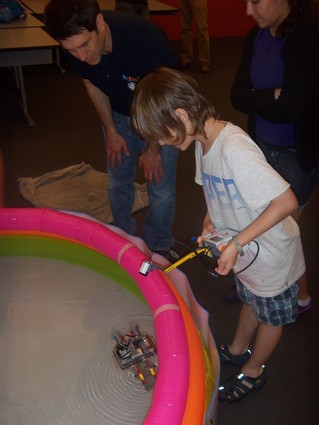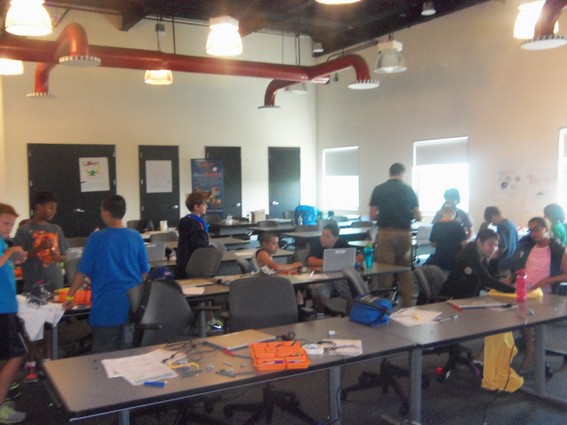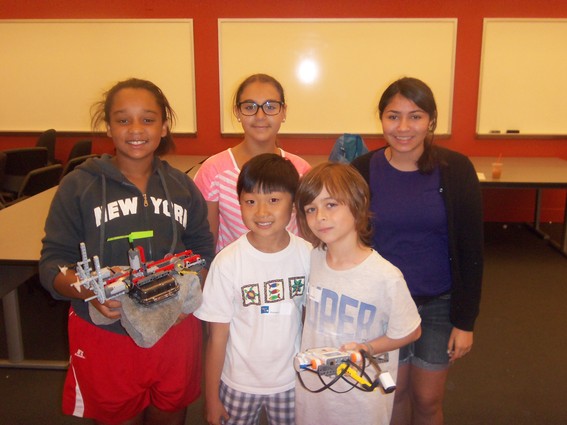Hoboken Students Learn STEM Concepts at Stevens Water Robotics Camp

Most kids use Lego bricks to build simple models of castles and other fixed structures. They then have to imagine what comes next.
But now some of them are using computerized Lego parts to build cool creations, like robots that can swim and can spot and snatch objects underwater.
In mid-July 2014, more than 20 middle-school students learned how to build those robots during the first week of the annual WaterBotics camp at Stevens Institute of Technology (Hoboken).
“WaterBotics is a middle- and high-school curriculum where students design, build and program underwater robots,” said Adam Scribner, a development specialist with the Stevens Center for Innovation in Engineering and Science Education (CIESE). “The program teaches thm what engineering is like as a career.”
The National Science Foundation began funding water robotics camps in 2006, during a New Jersey pilot program, and Stevens developed WaterBotics soon thereafter. The school now licenses the curriculum to camps across the country.
“The idea is to engage young people in understanding the process of engineering design, both because it’s an important goal for workforce development and because we need citizens who understand that,” said Arthur Camins, the CIESE director.

The curriculum is structured so students don’t need any previous experience with building a robot. “This is specifically designed for broad participation,” Camins said. “You don’t have to know anything to enter.” He added that half the WaterBotics students nationwide are girls.
At the Stevens camp, the students have to build different robot versions that can complete missions simulating real water problems.
“It is structured to bring students though a series of scaffolded design challenges,” said Mercedes McKay, the CIESE deputy director. “We start by having a very simple mission where they have to design and build a robot to float on the water. For this we provide a real-world context, to save a swimmer that is in distress, which is represented by a Ping-Pong ball.”
The students gradually add more motors to the robot for greater mobility and to fulfill new missions. “They’re then challenged with the second mission — to clean up an oil spill represented by many Ping-Pong balls,” McKay said. “As the week goes on, the third mission is to design a robot to go underwater. This is where the concepts of buoyancy and stability come into play. In the final mission they add a grabbing mechanism for a context that explores a sunken ship.”
While the students did use traditional Lego bricks for structure, they also used Lego’s NXT programming system to power and control their robots. Scribner said the old bricks and the new robotics combine to form an ideal teaching tool. “Lego teaches the iterative process of engineering so that students can design and build and rapidly prototype,” he said. “That’s important. You can take it apart and put it back together a lot faster than if you had to measure twice and cut once.”
The camp charges students a fee during its normal two-week schedule, though this year Stevens added a free extra week for Hoboken residents thanks to a grant from power company PSEG.
“We are committed to sparking curiosity and building a continued passion for students in the areas of science, technology, engineering and math through partnerships with colleges and universities and programs that engage and excite students in STEM subjects outside the traditional school day,” said Ellen Lambert, president of the PSEG Foundation, in a statement.
“Stevens has created a camp where kids can come and have the opportunity to learn basic engineering skills, apply mathematical concepts and more importantly, have fun using technology,” she added.
Three Hoboken girls who had worked together spoke about why they had participated in the camp and what they had hoped to learn.
“I was interested because it sounded like a great idea … to make robots and especially to [make them] go into water, because I would think that robots can’t be in water,” said Yasmine Petrocelli, who attends HoLa Hoboken Dual Language Charter School, a Spanish-immersion school for native English speakers.

| Alan Skontra
“I wanted to know more about engineering and using computers and robots and how they work,” said Skyler Williams, who also attends HoLa.
The girls learned to work together to overcome the challenges of building an underwater robot for the first time.
“We talked as a group, and we kept trying it over and over again to see if we could achieve it,” said Alyssa Ortiz, an eighth-grader at Hoboken Junior and Senior High School. “We failed many times, but we learned from the mistakes.”
All three girls said they would consider having a science career in the future.
“To me this is a good experience, because when I’m older I want to be an architect, so this kind of gives me a head start on how to do that,” Ortiz said.
“I think it’s really interesting,” Petrocelli said. “I might want to be an engineer when I grow up.”
“I also want to be an engineer when I grow up, and when I do I want to study robots and how they work,” Williams said.

